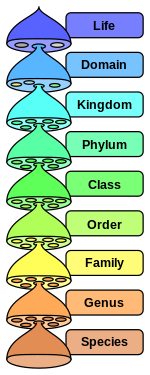Subspecies

In biological classification, subspecies (pl.: subspecies) is a rank below species, used for populations that live in different areas and vary in size, shape, or other physical characteristics (morphology), but that can successfully interbreed.[2][3] Not all species have subspecies, but for those that do there must be at least two. Subspecies is abbreviated subsp. or ssp. and the singular and plural forms are the same ("the subspecies is" or "the subspecies are").
In zoology, under the International Code of Zoological Nomenclature, the subspecies is the only taxonomic rank below that of species that can receive a name. In botany and mycology, under the International Code of Nomenclature for algae, fungi, and plants, other infraspecific ranks, such as variety, may be named. In bacteriology and virology, under standard bacterial nomenclature and virus nomenclature, there are recommendations but not strict requirements for recognizing other important infraspecific ranks.
A taxonomist decides whether to recognize a subspecies. A common criterion for recognizing two distinct populations as subspecies rather than full species is the ability of them to
Nomenclature
The
In botany, subspecies is one of many ranks below that of species, such as variety, subvariety, form, and subform. To identify the rank, the subspecific name must be preceded by "subspecies" (which can be abbreviated to "subsp." or "ssp."), as in Schoenoplectus californicus subsp. tatora.[8]
In bacteriology, the only rank below species that is regulated explicitly by the code of nomenclature is subspecies, but infrasubspecific taxa are extremely important in bacteriology; Appendix 10 of the code lays out some recommendations that are intended to encourage uniformity in describing such taxa. Names published before 1992 in the rank of variety are taken to be names of subspecies[9] (see International Code of Nomenclature of Prokaryotes). As in botany, subspecies is conventionally abbreviated as "subsp.", and is used in the scientific name: Bacillus subtilis subsp. spizizenii.[10]
Nominotypical subspecies and subspecies autonyms
In
The subspecies name that repeats the species name is referred to in botanical nomenclature as the subspecies "autonym", and the subspecific taxon as the "autonymous subspecies".[12]
Doubtful cases
When zoologists disagree over whether a certain population is a subspecies or a full species, the species name may be written in parentheses. Thus Larus (argentatus) smithsonianus means the American herring gull; the notation within the parentheses means that some consider it a subspecies of a larger herring gull species and therefore call it Larus argentatus smithsonianus, while others consider it a full species and therefore call it Larus smithsonianus (and the user of the notation is not taking a position).[citation needed]
Criteria
A subspecies is a taxonomic rank below species – the only such rank recognized in the zoological code,[13] and one of three main ranks below species in the botanical code.[12] When geographically separate populations of a species exhibit recognizable phenotypic differences, biologists may identify these as separate subspecies; a subspecies is a recognized local variant of a species.[14] Botanists and mycologists have the choice of ranks lower than subspecies, such as variety (varietas) or form (forma), to recognize smaller differences between populations.[12]
Monotypic and polytypic species
In biological terms, rather than in relation to nomenclature, a
In a monotypic species, all populations exhibit the same genetic and phenotypical characteristics. Monotypic species can occur in several ways:[citation needed]
- All members of the species are very similar and cannot be sensibly divided into biologically significant subcategories.
- The individuals vary considerably, but the variation is essentially random and largely meaningless so far as genetic transmission of these variations is concerned.
- The variation among individuals is noticeable and follows a pattern, but there are no clear dividing lines among separate groups: they fade imperceptibly into one another. Such clinal variation always indicates substantial gene flow among the apparently separate groups that make up the population(s). Populations that have a steady, substantial gene flow among them are likely to represent a monotypic species, even when a fair degree of genetic variation is obvious.
See also
- Breed
- Cultivar in botany
- Ecotype
- Form (botany)
- Form (zoology)
- Glossary of scientific naming
- Landrace
- Phenotype
- Polymorphism (biology)
- Race (biology)
- Species complex
- Strain (biology)
- Variety (botany)
References
Citations
- ^ hdl:10088/32616.
- ^ Mayr, E. (1982). "Of what use are subspecies?". The Auk. 99 (3): 593–595.
- ^ Monroe, B. L. (1982). "A modern concept of the subspecies". The Auk. 99 (3): 608–609.
- ^ "Species – Speciation". Encyclopedia Britannica. Retrieved 20 April 2021.
- ^ Linné, C. (1735). Systema naturae, sive, Regna tria naturae systematice proposita per classes, ordines, genera, & species. Lugduni Batavorum: Theodor Haak.
- ISBN 0853010064.
- ^ "Scientific Nomenclature". Centers for Disease Control and Prevention. Retrieved 20 January 2021.
- ^ James, Mallet (2007). "Subspecies, semispecies, superspecies" (PDF). Encyclopedia of Biodiversity. Elsevier. Retrieved 27 April 2018 – via UCL.
- ^ "International Code of Nomenclature of Bacteria: Bacteriological Code, 1990 Revision. - Chapter 3: Rules of Nomenclature with Recommendations". National Center for Biotechnology Information. Retrieved 17 January 2013.
- PMID 26596770. Full text available from PDF link at this page; direct URL to PDF is auto-generated and expires.
- ^ International Code of Zoological Nomenclature, Art. 47
- ^ ISBN 978-3-87429-425-6.
- ^ Rosenberg, Gary; et al. (eds.). "ICZN Glossary". International Code of Zoological Nomenclature. International Commission on Zoological Nomenclature.
- ISBN 978-1133418849.
- ISBN 9780674690103.
General and cited sources
- Barrow, M. V. (1998). A Passion for Birds: American Ornithology after Audubon. Princeton, NJ: Princeton University Press. ISBN 9780691044026.
- Lewis, D. (2012). The Feathery Tribe: Robert Ridgway and the Modern Study of Birds. New Haven, CT: Yale University Press. ISBN 9780300175523.
- ISBN 978-0-07-041144-9.
External links
 The dictionary definition of subspecies at Wiktionary
The dictionary definition of subspecies at Wiktionary
